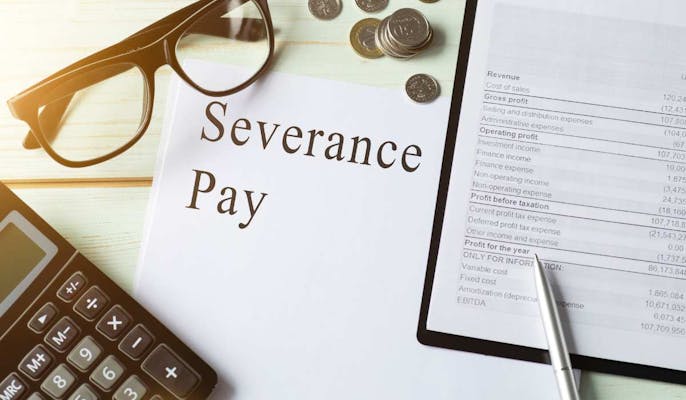Employees under a continuous contract for at least 24 months who are dismissed by reason of redundancy or laid off are qualified for severance payment.
Severance payment and Long service payment are either-or, not both.
SP = 2/3 × wages per year of service, with wage cap HKD 22,500 and overall cap HKD 390,000. Daily-rated staff use any 18 days’ wages out of the last 30.
Employee must serve a written SP claim within 3 months of dismissal or lay-off. Employer must pay within 2 months after receiving that claim. LSP is generally payable within 7 days of termination.
Employers cannot use mandatory MPF to offset the post-transition portion of SP/LSP, but the pre-transition portion can still be offset. Wage and global caps unchanged.
Statutory SP/LSP paid under the Employment Ordinance (Cap. 57) is not chargeable to Salaries Tax; excess over the statutory formula is taxable.
What Is a Severance Payment?
A severance payment is a statutory sum under the Employment Ordinance (Cap. 57) for eligible employees who lose their jobs due to redundancy or are laid off. It is calculated by a fixed formula and subject to statutory caps.
Severance Payment vs Contractual Termination
Severance payment (SP) is not the same as the normal payment an employer makes when ending a contract by giving the agreed notice.
SP is tied to the reason for termination—if the termination is due to redundancy or layoff, SP may apply even if proper notice or payment in lieu is given.
When SP May Apply
If an employee is dismissed by reason of redundancy or lay-off (for example, genuine business restructuring, downsizing, or closure of a business function), statutory SP may be payable once the other conditions are met, even if the employer has given proper notice or payment in lieu.
When SP Does Not Apply
If an employer ends the contract for reasons other than redundancy and the position continues to exist (for example, performance issues or a change of personnel), statutory SP does not apply, although the employer must still honour the agreed notice and any other contractual entitlements.
Differences Between Severance Payment and Long-Service Payment
Severance payment and long-service payment are two different concepts:
| Aspect | Severance Payment (SP) | Long Service Payment (LSP) |
|---|---|---|
| Trigger | Redundancy or lay-off (including certain terminations beyond the employee’s control). | Specific long-service grounds under the Employment Ordinance (e.g. dismissal other than summary dismissal, certain resignations, death, etc.). |
| Minimum service | At least 24 months under a continuous contract. | At least 5 years under a continuous contract. |
| Exclusivity | An employee can receive SP or LSP only, not both, for the same period of service. | An employee can receive SP or LSP only, not both, for the same period of service. |
| Payment deadline | Within 2 months after the employer receives the employee’s written SP claim. | Generally, within 7 days after termination. |
Calculating Severance Payment
To qualify for statutory severance payment, an employee must have at least 24 months of continuous employment and be dismissed by reason of redundancy or laid off under the Employment Ordinance.
Monthly-Paid Employees
- Formula: SP = 2/3 × (last full month’s wages or 12-month average, at the employee’s election) × years of service
- Wage cap: Monthly wages used in the formula are capped at HKD 22,500.
- Global cap: The total statutory severance payment is capped at HKD 390,000.
- Part-years: Calculated pro rata.
Daily-Rated or Piece-Rated Employees
- Use any 18 days’ wages out of the last 30 normal working days for each year of service, subject to the same wage cap and global cap.
Example
- If the last month’s wages are HKD 21,000 and the employee has 5 years of service, the severance payment is: HKD 21,000 × 2/3 × 5 = HKD 70,000 (within the statutory caps).
The Labour Department provides a Statutory Employment Entitlements Reference Calculator that both employers and employees can use to cross-check calculations.
Engaging professional accounting services can further ensure compliance with legal requirements.
Eligibility Criteria
You are generally eligible for severance payment (SP) if all of the following apply:
- You are employed under a continuous contract for at least 24 months; and
- You are dismissed by reason of redundancy, your fixed-term contract is not renewed due to redundancy, or you are laid off.
Redundancy includes situations such as business closure, closure of the place of employment, or where the employer’s need for work of that kind ceases or diminishes.
Domestic helpers
The same statutory tests apply. If a foreign domestic helper satisfies the 24-month continuous contract requirement and is dismissed due to redundancy or lay-off (rather than for serious misconduct), SP may be payable.
Payment Procedures and Timelines
- The employee must serve a written severance payment (SP) claim within 3 months after dismissal or lay-off.
- The employer must pay statutory SP within 2 months after receiving that written claim.
- If long service payment (LSP) applies instead of SP, it is generally payable within 7 days after termination.
Failure to pay statutory SP/LSP in accordance with the Employment Ordinance (Cap. 57) may amount to a criminal offence. Employers should refer to the Labour Department’s Chapter 11 guide for current offence types and penalty levels.
End of MPF Offsetting in 2025
- From 1 May 2025, employers cannot use employer mandatory MPF contributions to offset the post-transition portion of severance payment (SP) or long service payment (LSP).
- For the pre-transition portion of SP/LSP (i.e., entitlements accrued for service before the transition date), employers may still apply the old offsetting rules in line with the statutory transitional arrangements.
- The wage cap of HKD 22,500 and the overall cap of HKD 390,000 for SP/LSP remain unchanged.
- Employers should keep clear records that distinguish pre-transition and post-transition service/entitlements to demonstrate compliance. Government guidance and subsidy tools are available through the Labour Department and the MPFA to help employers manage the change.
Tax Treatment of Severance and Long Service Payments
Not Taxable
Statutory severance payment (SP) and long service payment (LSP) paid under the Employment Ordinance (Cap. 57) are not chargeable to Salaries Tax.
Taxable
Any amount paid in excess of the statutory formula and most other termination payments (for example, ex gratia sums or additional contractual payouts) are generally taxable under Hong Kong Salaries Tax, assessed by the Inland Revenue Department (IRD).
Optional Add-Ons in a Severance Package
Employers in Hong Kong sometimes offer non-statutory severance benefits alongside statutory SP/LSP, such as:
- Career coaching or outplacement/job search support
- Short-term medical or insurance cover
- Extra ex gratia payments or notice in lieu
These add-ons are optional and do not affect statutory severance payment (SP) or long service payment (LSP) entitlements under the Employment Ordinance.
Need help applying the new MPF offsetting rules or drafting clear, compliant termination letters
Air Corporate can review eligibility, calculate SP/LSP under the 2025 rules, and prepare legally compliant severance paperwork so you reduce risk and stay onside with Hong Kong law.
FAQs
Severance pay is 2/3 of your last full month’s wages or 12-month average (capped at HKD 22,500), multiplied by your years of service (part-years pro rata), subject to a HKD 390,000 overall cap.
Standard statutory severance is 2/3 of capped monthly wages × total years of service, up to HKD 390,000.
Yes, if a domestic helper has at least 24 months’ continuous service with the same employer and is dismissed (or not renewed) due to redundancy.
Statutory severance (and long service) payments are not taxable, but any amount above the statutory entitlement is generally taxable.
You must have 24 months’ continuous employment and be redundant or laid off (not dismissed for serious misconduct or resigning without a qualifying ground) under the Employment Ordinance.



